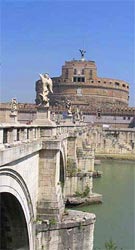 |

Home Page
Rome History
Monuments:
· Pantheon
· Colosseum
· Roman Forum
· Spanish Steps
· Trevi Fountain
· Saint Peter
· Capitoline Hill
· Castel Sant'Angelo
· Santa Maria Maggiore
· Piazza Navona
Rome Museums:
· Vatican Museums
· Capitolini Museums
· Villa Borghese
Gastronomy in Rome
Shopping in Rome
Events in Rome
Music in Rome:
· Auditorium
· S. Cecilia
· Theater of the Opera
Useful Links
:: SILVER HOTELS COLLECTION · MONUMENTS · CASTEL SANT'ANGELO ::
![]()
 Originally built as a mausoleum by the will of the Roman emperor Hadian in 135, Castel Sant'Angelo was to be the place that the emperor and his family would rest after their death. The mausoleum was completed in 139, a year
after the death of Hadrian, and the ashes of his cremated body were later placed here along with those of his son Lucius Aelius, who died the same year, and those of his wife Sabina.
Originally built as a mausoleum by the will of the Roman emperor Hadian in 135, Castel Sant'Angelo was to be the place that the emperor and his family would rest after their death. The mausoleum was completed in 139, a year
after the death of Hadrian, and the ashes of his cremated body were later placed here along with those of his son Lucius Aelius, who died the same year, and those of his wife Sabina.
Also known as the Tomb of Hadrian, Castel Sant'Angelo was erected on the right bank of the Tiber River in Rome.
Its structure is cylinder shaped with a roof garden and a monument of the emperor's two-wheeled chariot drawn by four harnessed horses. Other succeeders were also buried here and the last recorded emperor to take his final resting place in the mausoleum was Caracalla in 217. The mausoleum was converted into a military fortress in 401 and in 403, the Aurelian walls were built with potential to resist the even the most powerful assaults, especially that of the Visigoths and the Ostrogoths in 537.
When Rome was pillaged by Alaric in 410, the urns containing these important ashes were stolen and scattered. Remains of other important artefacts are stored in the Treasury room deep within the building. From tomb to fortress, the structure later took on another conversion, that of a castle in the 14th century. Pope Nicholas III had the castle connected to Saint Peter's Basilica by a covered and fortified corridor called the Passetto di Borgo.
When Rome was sieged again in 1527, the fortress castle served as a hiding place for Pope Clement VII as well as a prison by the Papal state. The castle was also a famous setting for Giacomo Puccini's renowned opera Tosca who leaped to her death from the ramparts of the terrace.
Legend tells that the name Castel Sant'Angel derives from a miraculous event which took place during the midst of a severe plague in 590. A procession of prayer was organized by Pope Gregory inviting all to pray for an end to the deadly plague. When the procession reached the tomb of Hadrian, Archangel Michael was seen atop the mausoleum sheathing his flaming sword, as assign symbolizing the end of the Plague. In remembrance to this event the name of the monument was changed and a statue of the angel, Saint Michael, was put on the top as a tribute to the event.
In 1901, after over a thousand years of use as both a fortress and castle, Castel Sant'Angelo was decommissioned and became what is now the National Museum of Castel Sant'Angelo. The Castle is divided into five floors; Floor I has a famous 400 feet long winding ramp. Floor II, also known as the Floor of Prisons, contains the historical prisons cells, as well as store-rooms for wheat and oil. Floor III, also known as the MilitaryFloor, has two large courtyards Floor IV, also called the Papal Floor, includes the loggia of Julius II by Bramante and the papal apartment with its magnificent rooms and frescos by famous painters of Raphael's school. On the top floor you will find a large terrace dominated by an Archangel in bronze by
Wersschaffelt and of course an amazing panorama over the city of Rome.